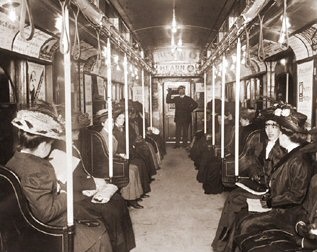They were called “suffragette cars” when they were introduced in March 1909 on trains of the Hudson Tubes, which took passengers from Manhattan to Hoboken (today’s PATH).
 And test runs of these single-sex subway cars—the last car in each train reserved for women only during rush hours—were also deemed a success. So much of a success, IRT officials considered the idea for the then–five year old New York City subway.
And test runs of these single-sex subway cars—the last car in each train reserved for women only during rush hours—were also deemed a success. So much of a success, IRT officials considered the idea for the then–five year old New York City subway.
One women’s group, the Women’s Municipal League, supported the idea, while a host of others opposed it, stating that it was impractical and unnecessary.
After months of debate, the idea was abandoned. Officials decided that the Hudson Tube women-only cars weren’t that successful after all, and that women didn’t want them anyway.
Said one official in an August 1909 New York Times article:
“Almost an equal number of people (to the advocates of women’s cars) stated that men are the best protection that women have in a crowded car, and that they prefer to ride in cars where men and women are together, that while there are rare occasions when some brute will take advantage of the situation to insult a lady, on the other hand the gentlemen are the best protection the ladies want against such conduct.”
And subway pervs all over the city continued rubbing up against chicks in crowded cars. . . .
[1909 Hudson Tubes photo from Photographs of Old America]








